Acton was one of the largest concentrations of industry, particularly automobile, in the South of England
In the latter part of the 19th century, a considerable number of small laundries opened serving the needs of the hotels and the wealthy living in the
The industrial areas of Acton Vale became available at the turn of the century, and comprised parts of the common fields which had initially been used for the making of bricks. The area was free of the building restrictions imposed inside the London County Council area, and therefore an attractive and economic site creating a cluster of large developments including Napiers (engines and vehicles), Wilkinson Sword (swords, razors, vehicles), CAV and Lucas (automobile components), Evershed and Vignoles - (electrical test equipment), Du Cros (Cars) and Eastmans (Dye).
Ten years later, a further cluster of industries developed at Park Royal in north
The heavy industry moved away from
D. Napier and Son
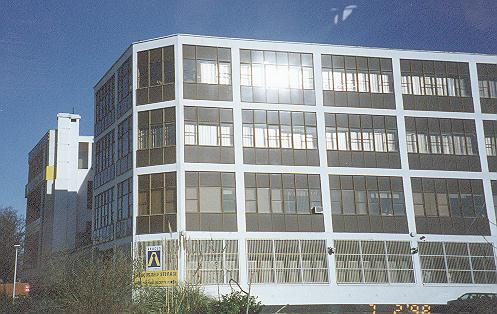
The Napier works (built 1915). Napiers made cars, aircraft and marine engines in an extensive factory in Acton Vale.
The clock from the Napier factory, Acton Vale.
The firm moved to the Napier Motor Works in Acton Vale in 1903, where the company manufactured a developing range of engines and vehicles. The works had extended to cover 6 ½ acres by 1906 and was employing 1,000 people making 200 cars per year together with motor boat engines.
From the start of the war in 1914, the company reduced its production of cars, and was manufacturing aircraft engines under government contract including the “Lion” engine, which became the company's main product line. The government contract required the construction of a new concrete multi story building facing Acton Vale, shown above.
During the second world war, production of aircraft engines was increased, but the
Napier Car
1900 Napier car.
Napier Car
1933 Napier Railton (powered by a Lion aero engine) from the Brooklands Museum alongside a Napier Deltic Locomotive
For more information on Napier see the Napier Power Heritage Trust
Du Cros
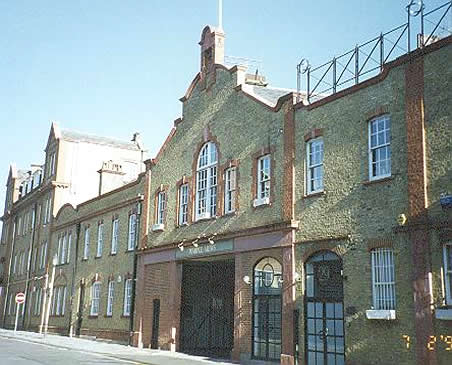
The Du Cros Car factory in
The company in Acton was founded by William Harvey du Cros (pronounced dewcrow) who was of Hugenot descent. He was the founder and first and only president of the Dunlop Rubber Co. He represented
In 1908, he set up a garage and repair works in
The works were built to facilitate the operation and maintenance of a fleet of taxi-cabs, and undertaking vehicle body building. A contemporary 1910 photograph shows an impressive line up of four cylinder 15 h.p. Napier taxis owned by W & G du Cros outside the works with their immaculately and uniformly dressed white-coated drivers. The 1000 strong taxi fleet, most of which had Panhard & Lavasseur bodywork, and CAV ignition and lighting systems, all from adjacent factories in

On the outside of the factory is a foundation stone that appears to be inscribed “This stone was laid on June 19th 1909 by Harvey du Cros esq. J.P. Founder of the pneumatic tyre industry”.
From operating fleets of taxis, the company expanded to the manufacture of chassis and bodies for buses and lorries. As well as the manufacture of the vehicles, there was a business operating a fleet of buses on private hire and a fleet of a hundred or more lorries on a contract basis.
These are very few vehicles of this make surviving - a 1927 Metropolitan Asylums Board ambulance restored and in the care of the London Ambulance Service and three trucks that were built in Acton during 1924/5 that survive in Australia.
The Vintage Lorry Annual No. 1, Nick Baldwin, ISBN 0906116074, Marshal, Harris and Baldwin, 1979, has an extensive article on the family and business.
Evershed and Vignoles
The Evershed electrical equipment factory,
This company, founded in 1895 and moved to Acton Green in 1903, manufactured electrical equipment, and in particular the “megger” range of electrical testing apparatus. The product range developed to include steering gear for the navy and aircraft instrumentation.
Acton Aerodrome and the Alliance Aeroplane Company
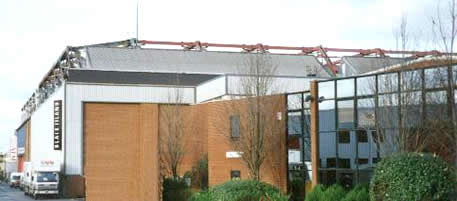
The Alliance Aeroplane Factory, built during the First World War on the edge of Acton Aerodrome in Park Royal. The site is now an industrial estate and leisure park!
In 1909, the pioneer aviator, Harold Pifford was experimenting with flight from a field in North Acton, managing to fly at a height of a couple of feet for about 100 yards in a bi-plane constructed in his studio at Bedford Park. Unfortunately, the aircraft was destroyed by a gale soon after its first flight and Pifford moved to
A small airfield was set up in 1910 as “The London Aviation Ground” on the triangle of land now bounded by
In 1913, flying displays were given by G T Lee and Claude Graham White. Public flying continued until the war, when the site was taken over by the National Guard.
The Ruffy Arnell and Baumann Aviation Co. moved from Hendon to the
In 1917, Ruffy-Baumann began to develop aircraft. The Advanced trainer was a single seat bi-plane with a 60 h.p. Anzain engine and the two seater had a 70 h.p. Renault engine, which was later to become the Alliance P1. They were taken over in the summer of 1918 by the Alliance Aeroplane Company formed by the furniture makers Waring and Gillow who were already making tents at the
The factory was taken over in 1925 and used until the mid 1930’s, by the car manufacturer Renault, who built another factory along side, on the site still occupied by their extensive car dealership. The building returned briefly to the production of aircraft in the Second World War, manufacturing Avro Anson fuselages and wings for the DeHaviland mosquito. The southern half of the building still remains (in use as a store), as a tribute to
George Lee Temple

Memorial in
https://www.gutenberg.org/files/777/777-h/777-h.htm#link2HCH0044
George Lee Temple lived in
George T Temple has his memorial (on the side of his son’s) and the inscription reads 'In loving memory of George Theodore Temple, Lieut. Commdr. R.N., F.R.G.S. Born 24 October 1847, passed away 21 February 1935. "He too has passed." “Templa quam dilecta.” ' ("How beautiful are thy temples")
Philippa died in May 1924. Her memorial (on the side of her son’s) reads - 'In ever loving memory of Philippa Desiree Temple, "Little Philine", the dearly-loved wife of George Theodore Temple. Born 8 Nov. 1853, passed away from us 30 April 1924. A devoted wife and mother. Unselfish, true and tender to the last. At rest in the haven where she would be. "Death is not death, for Christ has conquered death."
More information on George Lee Temple can be found at:
https://earlyaviators.com/etemple1.htm
www.findagrave.com/cgi-bin/fg.cgi?page=gr&GRid=11424360
Compton Organs

Park Royal Show
In 1900, The Royal Agricultural Society decided to develop a permanent site for their Annual Show. One Thousand Acres at Twyford Abbey were leased, and a n operating company "Park Royal Ltd." set up to run it. The name was given because the RAS had a Royal patron, and the name has stuck ever since.
The site comprised show rings and stands, the GWR built a special station, and the "Plumes" public house was built.
The first show was in June 1903, but they ware not a great success, so after the 1905 show, the land was sold. The grounds were used for other events, and QPR football club played there until after the First World War. During the war, the grounds were used by the government as a depot and munitions works.
The only remaining element of the Park Royal Showground is the former "Plumes" public house.
Industry developed on the former site of the Royal Agricultural Society Show to the north of
Roads in the area commemorate some of the marques of car manufactured in the area - Minerva, Standard and Sunbeam.
The Rootes Group developed from a small cycle shop in
Wilkinson Sword
Henry Knock, an expert gunmaker opened premises in Ludgate Hill in 1772. The business passed to his son-in-law James Wilkinson and subsequently to his son Henry. The business continued to develop firearms, but in the mid 19th century, Henry introduced the production of swords and developed a machine for testing the blades. The test, still used today, gained The Wilkinson Sword Company a reputation for quality. In 1898, the company introduced the manufacture of the ‘
The Company moved from
Acton Sewage Works
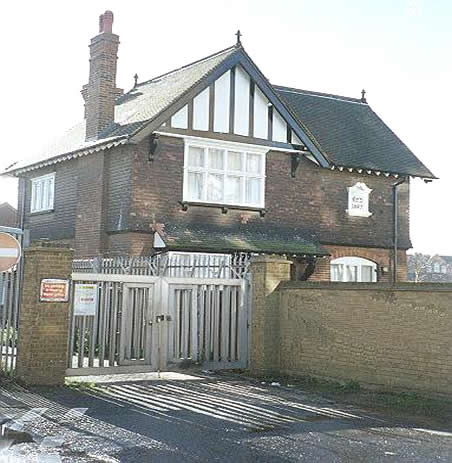
The Engineers House at Acton Sewage Works (1887) one of the proud achievements of the Acton Local Board.
It was decided, however, that all houses built in
This unusual arrangement was resolved in 1905 with a scheme prepared by Sir Alex Binnie. The normal flow of the sewers passed to the London County Council system at the expense of
South Acton – Soapsud Island
The early laundries simply used the facilities available in the home, but soon extensions were made to the rear of the houses to create a laundry room. Speculative builders realising that there was a demand, built laundry houses with the required facilities, and incorporated a carriage entrance to allow the laundry vans to reach the rear yard. Typically, the ground floor was used for the washing and boiling, with the upper floor used for mangling, ironing and finishing. Ironing was done using irons of cast iron heated on a pagoda stove. The finishing of delicate lace was the most skilled of the professions.
In total, over 600 laundry sites (not all at the same time) have been identified within South Acton, and this may well be an under estimate as several sites were operated under a common management. By 1885 there were sufficient businesses for a Laundry Proprietors’ Association to be formed to promote the interests of the laundry owners. The businesses, not only employed washers, launderers, and ironers, but also Carmen and gave business to suppliers of washing materials and baskets.
In the small laundries, all the work was done by hand with tubs and wash-boards. Over time, the bigger of the laundries became factories with power washing machines and steam calendars, whilst the smaller laundries declined.
The smaller laundries lost trade to the larger and more efficient “factory laundries”, and the decline set in. After the Second World War social conditions changed, and more people were doing their own washing at home using an electric washing machine or in local launderettes. The business had become mainly for the hotel and catering trades, rather than for domestic business.
The area became run down, and the council began purchasing property for a redevelopment scheme. In the 1950/60’s the whole of the area west of the North London Railway was cleared, and the small terrace houses were replaced with blocks of flats and high rise tower bocks, to the high standards of the time. Although initially popular, these high rise developments are now being replaced with the smaller terrace-style housing that is more popular today.
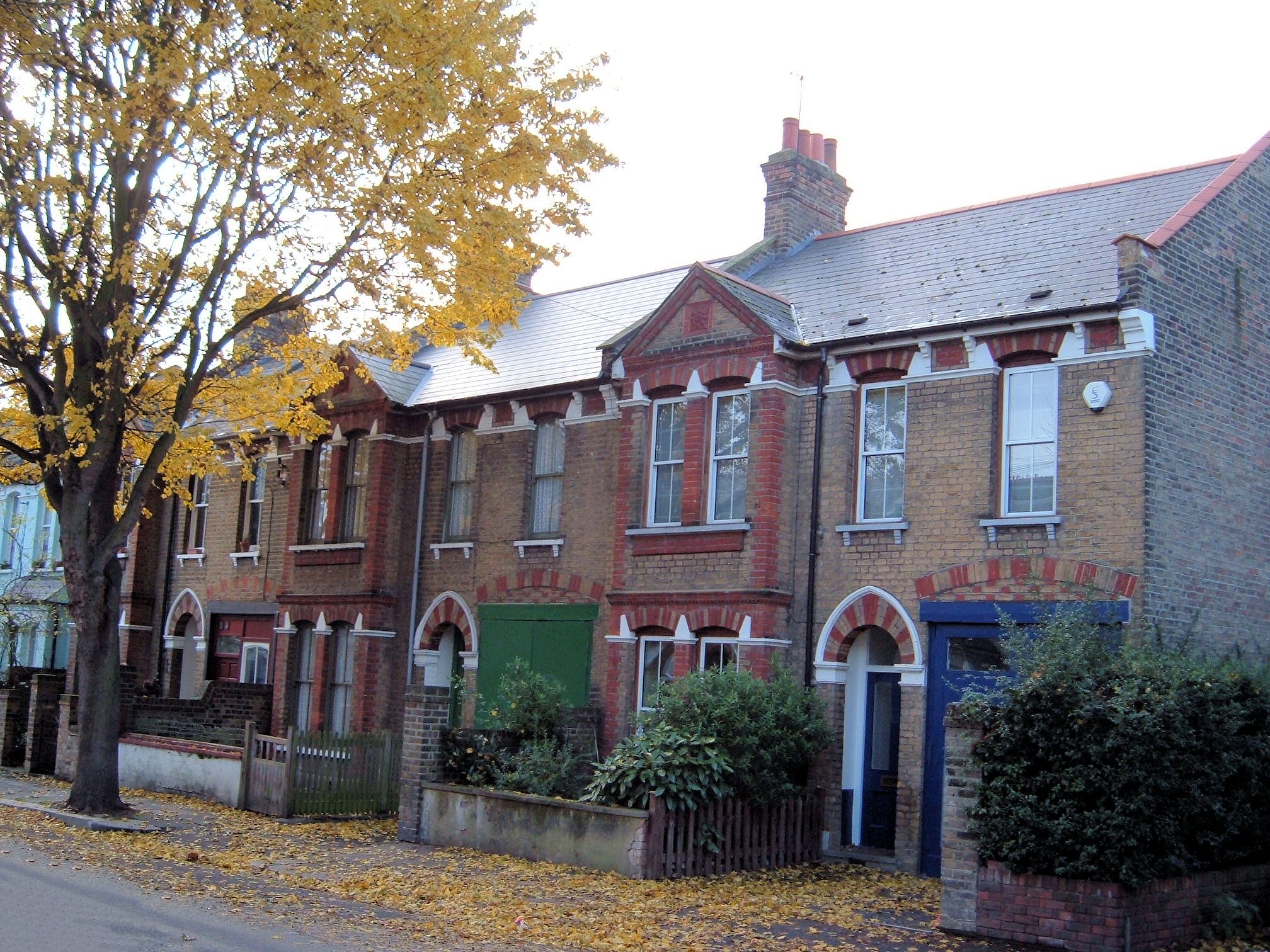
The type of building typically used as a laundry.
Acton's Nature
Whilst
